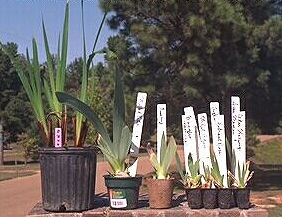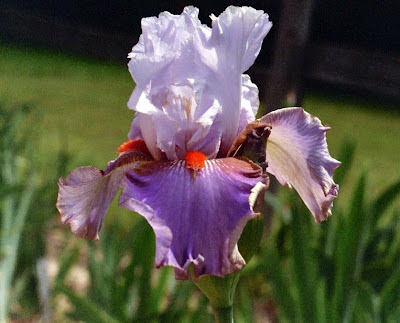

As boxes of rhizomes arrive at homes around the country, and gardeners talk about their new treasures, the discussion sometimes turns to the practice of potting. Some gardeners view potting rhizomes as an unnecessary extra step. Other gardeners view it as an integral part of their iris gardening. Though the practice was once considered unusual, it appears that many gardeners have added potting to their gardening routine as they learn more about the potential benefits offered. But, just how many? A recent survey of iris enthusiasts showed that 12% of respondents potted all of their newly dug rhizomes each year. Another 10% responded that they potted any rhizomes that required special care. The remaining 78% indicated that they planted all of their rhizomes directly in the garden. With 22% of respondents potting to some extent each year, let’s take a closer look at the “why” and “how” of this practice.
Of that 22%, the majority indicated that they employed potting to help protect newly dug rhizomes from extreme environmental conditions while establishing new roots. In the South and Southwest, gardeners wanted to minimize exposure to excess heat and humidity. In many cases, these gardeners also wanted to delay the chores of reworking the soil and planting until the cooler weather of fall. In the North, gardeners potted rhizomes that arrived late in the season, when planting directly in the garden increased the risk of freeze damage. Gardeners who indicated they employed potting with rhizomes that were small, with rhizomes that appeared to be struggling in some way, and with rhizomes that warranted special care came from all geographic regions.
Perhaps the most widely read information about potting rhizomes was written almost twenty years ago by Walter Moores, who grows and hybridizes irises in Yalobusha County, Mississippi. Mr. Moores has introduced almost 90 cultivars since 1977, and 18 of those have received AIS awards. His earlier work focused on reblooming irises, some of which can still be found in commercial catalogs today -- almost 40 years later! His recent work focuses more on tall bearded irises and species crosses. Having written about the subject of potting in an issue of the AIS Bulletin, Mr. Moores followed up with an article in the Tall Bearded Iris Society's Tall Talk (September 1998). Demonstrating that this information can prove useful in diverse climates, the article has been reprinted by many local clubs throughout the United States and now also appears on the current webpage of the Canadian Iris Society. Rather than trying to rewrite a classic, Mr. Moores’ original article is presented here, with just a few additional notes at the end.
Mr. Moores recently stated that the one change he would make to the above article is to add this advice: "When potting rhizomes, remove the leaves as they die to prevent moisture accumulation."
Additional Notes:
Magic Earth is recommended in the article above, but it is no longer
available. Magic Earth had a guaranteed analysis of 9-6-5. As a
substitute, look for an organic potting soil with a similar analysis,
such as Miracle Gro Organic Potting Soil. Do not use Miracle Gro's
standard potting soil, as it typically has too much nitrogen for use
with bearded irises. Once you have selected an appropriate potting soil,
it can be amended to best suit your climate. Common amendments used
when potting bearded irises include Canadian sphagnum moss, coarse sand, horticultural
vermiculite, bone meal, dolomitic lime, Super Phosphate, and granular fungicide. If adding fertilizer, choose one that is slow-releasing and low in nitrogen. Select free-draining pots from 4" to 6" in diameter.
Do you have a technique or cultural practice that has proven beneficial in your iris gardening? Share it here!























































.jpg)
.1.jpg)
.JPG)
.JPG)